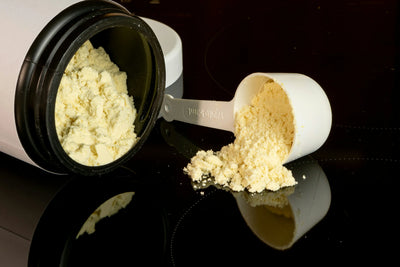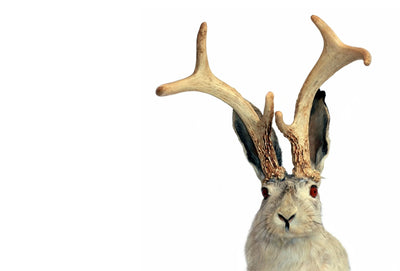What the New Lead Contamination Report Reveals?
Why You Should Worry About Heavy Metals in Protein Powders?
A recent Consumer Reports investigation revealed concerning findings about many popular protein powders and ready-to-drink shakes. Among 23 tested products, more than two-thirds contained lead levels exceeding their self-imposed “daily lead intake limit” (0.5 µg/day), based on California’s Prop 65 standard — which is stricter than FDA guidelines.
Plant-based protein powders (such as pea or rice protein) were found to contain up to nine times more lead than whey-based products.
This discovery doesn’t just affect people using protein powder for workouts — it also raises a red flag for pet owners who sometimes add human protein powder to their dog’s diet, or whose pets accidentally ingest it.

Can Dogs Eat Protein Powder?
What Exactly Is Protein Powder?
Protein powder is a processed supplement made from concentrated protein sources like whey, casein, egg, or plant-based proteins (soy, pea, rice, etc.). It’s designed for human nutritional needs, mainly for muscle recovery, fitness, or weight management.
However, human protein powder formulas often include additives like artificial sweeteners, flavoring agents, preservatives, and amino acid blends — all of which are not formulated for pets and can sometimes be unsafe.

Is It Safe for Dogs to Eat Human Protein Powder?
In short: no, it’s not recommended.
While a tiny accidental lick is unlikely to cause harm, regular or intentional feeding of human protein powder to pets can be risky.
Here’s why:
- Dosage mismatch — Human protein levels are much higher than what most pets need, and chronic over-supplementation can overwork a dog’s or cat’s kidneys.
- Toxic ingredients — Common protein powder additives like xylitol, stevia, caffeine, or chocolate flavoring can be toxic to pets.
- Contamination risks — The latest report revealed lead, cadmium, and arsenic contamination in several major protein powder brands, posing an additional danger for animals with smaller body weights and slower detox metabolism.
Why Heavy Metal Contamination Poses a Bigger Risk to Pets?
Consumer Reports’ testing found that some protein powders contained up to 6.3–7.7 µg of lead per serving, far above the 0.5 µg/day threshold they recommend.
Lead is a well-known neurotoxin, associated with learning deficits, hyperactivity, and neurological damage in children — and pets are even more sensitive.
Even small, chronic exposures can lead to:
- Neurological problems (lethargy, tremors, confusion)
- Gastrointestinal distress
- Kidney and liver strain
- Developmental issues in young pets
Experts stress that “no amount of lead exposure is completely safe”, and that applies equally to pets.
What to Do If Your Pet Eats Human Protein Powder?
1. Observe closely. If your dog or cat only consumed a small amount (a lick or two), monitor for vomiting, diarrhea, or lethargy.
2. Do not continue feeding the product. Move protein powders out of your pet’s reach.
3. Contact your vet if your pet is very young, senior, or has pre-existing kidney/liver issues, or if they consumed a large quantity.
- The vet may suggest lab tests or even heavy metal screening, though it’s less common in veterinary practice than in human medicine.
4. Never use human protein powder as a regular supplement. Only use products specifically formulated for animals.
Safe Ways to Support Your Pet’s Protein Intake
- Balanced diet first: Most healthy adult dogs and cats already get adequate protein from quality pet food.
- Vet-approved supplements only: If extra protein is needed (e.g., post-surgery, muscle loss, recovery), use veterinary-formulated protein supplements with transparent ingredient lists and third-party lab testing.
-
Avoid plant-based human protein powders — they tend to have higher heavy-metal contamination.
-
Proper storage: Keep human supplements and protein powders out of pets’ reach to prevent accidental ingestion.
References
1.American Veterinary Medical Association. (2017, October 15). Finding lead in pets. JAVMA News. Retrieved from https://www.avma.org/javma-news/2017-10-15/finding-lead-pets
2.Clean Label Project. (2024). 2024-25 Protein Powder Category Report. Retrieved from https://cleanlabelproject.org/wp-content/uploads/CleanLabelProject_ProteinStudyWhitepaper_010625.pdf
3.Maddison, J. E., & Allan, G. S. (1990). Lead toxicosis in cats — A review. Australian Veterinary Journal, (One of the series reviewed in “Lead toxicosis in cats—a review”). Retrieved from https://pmc.ncbi.nlm.nih.gov/articles/PMC10822269/
4.Moses, E., & Ehireme, I. A. (2025). Animal exposure to lead, mechanism of toxicity and treatment strategy — a review. Clinical Case Reports and Studies, 9(1), 1-9. https://doi.org/10.59657/2837-2565.brs.25.212
5.Parasuraman, S., Raveendran, R., & Rahman, S. (2016). A human health risk assessment of heavy metal ingestion among protein powder supplement users. Food and Chemical Toxicology, (…) Retrieved from https://pmc.ncbi.nlm.nih.gov/articles/PMC7509468/
6.Sanders, T., Liu, Y., Buchner, V., & Tchounwou, P. B. (2009). Neurotoxic effects and biomarkers of lead exposure: A review. Reviews on Environmental Health, 24(1), 15-45. Retrieved from https://doi.org/10.1515/REVEH.2008.24.1.15
7.Schmitt, J., Jaeger, D., Förster, I., & Becker, J. (2016). Risk assessment of feeding dogs trimmings of lead-shot game. BMC Veterinary Research, 12, 132. Retrieved from https://doi.org/10.1186/s12917-016-0771-z
8.Taylor, M. (2016). The detrimental effects of lead on human and animal health. Veterinary World, 9(6), 660-665. Retrieved from https://www.veterinaryworld.org/Vol.9/June-2016/20.html
9.Thompson, J., & … (2023). A review of important heavy metals toxicity with special emphasis on animals. Frontiers in Veterinary Science, 10, 1149720. Retrieved from https://doi.org/10.3389/fvets.2023.1149720
10.“Lead poisoning in animals — Toxicology” (n.d.). The Merck Veterinary Manual. Retrieved from https://www.merckvetmanual.com/toxicology/lead-poisoning/lead-poisoning-in-animals








